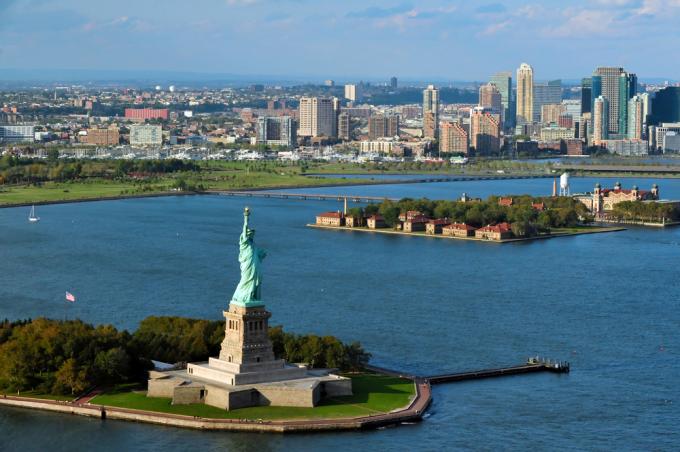The Statue of Liberty is a monument that is located on Liberty Island in New York. she represents "Freed” the Roman goddess of freedom and was offered by the French as a gift by the centenary of American independence.
considered UNESCO World Heritage Site in 1984, the Statue of Liberty was made of copper, steel, cast iron and gold. It is considered the heaviest sculpture in the world, weighing 255 tons.
The responsible sculptor was Frederic-Auguste Bartholdi, which had the help of engineer Alexandre-Gustave Eiffel, who years later was responsible for the design of the Eiffel Tower.
The statue's official name is “freedom lighting the world” "liberty enlightening the world"). Every year, around 4 million people visit the monument - the journey to the island is made by boat or ferries.
 Statue of Liberty on Liberty Island in Manhattan, New York.
Statue of Liberty on Liberty Island in Manhattan, New York.
Statue of Liberty Features
The Statue of Liberty weighs 255 tons, is 46.5 meters tall without the pedestal and 92.99 meters with the pedestal.
In the statue's right hand is a fire torch - which represents freedom - and in the left hand, a board where it is written July 4, 1776 in Roman numerals - date of the Declaration of Independence of States United.
It is possible to climb to the crown of the statue, where there are 25 windows. Access to the crown is only by stairs, there are 354 steps - the equivalent of a 22-story building.
Its crown has 7 rays, which represent the 7 continents and 7 seas of the world.
Originally the Statue of Liberty was reddish-brown as it was clad in copper. But due to exposure to rain, wind, and pollution, this material oxidized and the statue turned blue-green.
 Statue of Liberty on the pedestal.
Statue of Liberty on the pedestal.
Understand how the story of the United States Independence.
History of the Statue of Liberty
The Statue of Liberty was a gift from the French people to the American people in celebration of the 100 years of US Independence, which was completed in 1886.
The idea was proposed by French historian Edouard de Laboulaye in 1865, who suggested offering a statue to the United States to celebrate the country's success in building a democracy.
His project was a partnership between the two countries: the statue would be made by France and the pedestal by the Americans. The pedestal was designed by American architect Richard Morris Hunt.
Frederic-Auguste Bartholdi, famous French sculptor, was responsible for the sculpture. The structure of the statue was designed by engineer Alexandre-Gustave Eiffel and architect Eugène-Emmanuel Viollet-le-Duc.
Various events and exhibitions were organized in the United States and France to raise funds for the construction of this huge monument.
The construction of the statue was completed in Paris in July 1884 and the sculpture was divided into around 350 pieces, which were packed and transported by the French frigate Isere.
This journey took a year and the pieces arrived in New York in 1885. It took 4 months to assemble the statue, which was opened in October 1886.
In 1986, in celebration of 100 years of its existence, the Statue of Liberty underwent a major renovation. The entire statue was cleaned and its crown replaced as it was corroded.
The Statue of Liberty is one of the Seven Wonders of the Modern World and one of the most important tourist spots in the United States. In addition to freedom, it represents the democracy and the hope.
know more about freedom and democracy.


